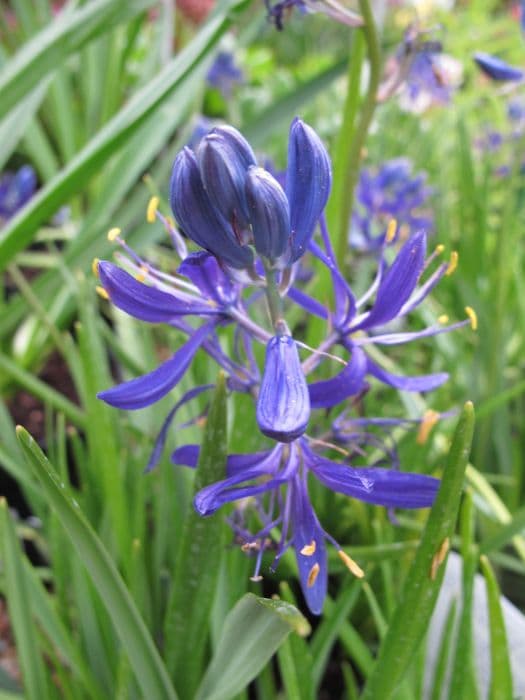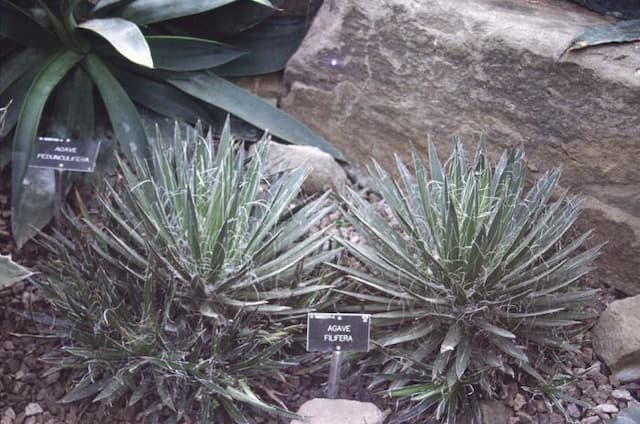Camas Camassia quamash

ABOUT
Camassia quamash, commonly known as common camas, is a perennial plant that is recognized for its striking star-shaped flowers. The flowers are typically a deep blue or purple color, though they can occasionally be found in lighter shades of blue to almost white. These blossoms form in a raceme, which is a cluster where the individual flowers are attached by short stalks along a central stem. Each flower has six petals that spread outward, creating an open, star-like shape. The leaves of the common camas are basal, meaning they grow from the base of the stem. They are long and sword-shaped with a slightly wavy margin and a glossy green appearance. They ascend directly from the ground and can often form a dense, grassy clump. The plant emerges from a bulb, which historically has been an important food source for various indigenous peoples of North America. The plant typically flowers in the late spring to early summer. Once flowering is finished, the plant will produce capsule-like fruit that splits open when mature, releasing small black seeds. The common camas grows naturally in meadows, prairies, and along stream banks, preferring moist environments with well-drained soil. The visual charm of the common camas lies not only in its alluring flowers but also in its orderly, vertical growth habit and the lush, verdant backdrop provided by its foliage, which showcases the floral display prominently. This combination of features makes the common camas a popular choice for naturalizing in gardens and for adding a splash of color to wildflower meadows.
About this plant
 Names
NamesFamily
Asparagaceae.
Synonyms
Camas, Small Camas, Quamash, Indian Hyacinth, Wild Hyacinth.
Common names
Camassia esculenta, Camassia leichtlinii var. suksdorfii, Phalangium quamash, Quamasia hyacinthina, Quamasia quamash, Scilla esculenta
 Toxicity
ToxicityTo humans
Camas, specifically Camassia quamash, is generally not toxic to humans if properly prepared; in fact, it has been historically used as a food source by various Native American tribes. However, it's important to note that the bulbs must be cooked properly to break down naturally occurring inulin into fructose, which makes it edible. If camas bulbs are eaten raw or undercooked, they can cause gastrointestinal discomfort due to their high inulin content. Ensuring the bulbs are thoroughly cooked can prevent this issue. Moreover, it is crucial to correctly identify camas as it can be easily confused with the toxic death camas (Zigadenus species), which can lead to serious poisoning characterized by nausea, vomiting, abdominal pain, and possibly more severe symptoms such as hypotension or bradycardia if consumed.
To pets
Camas is not widely known for being toxic to pets, but as with humans, the primary concern is the potential confusion with the toxic death camas, which can be very harmful to animals. If a pet were to ingest parts of the genuine Camassia quamash, especially in large quantities, it could experience mild gastrointestinal upset due to the inulin content. Conversely, if a pet ingests death camas, thinking it is Camassia quamash, it could suffer more severe symptoms including salivation, vomiting, hypotension, seizures, or even death without prompt veterinary treatment. It's important therefore to prevent pets from ingesting unknown wild plants and to seek veterinary attention if poisoning is suspected.
 Characteristics
CharacteristicsLife cycle
Perennials
Foliage type
Deciduous
Color of leaves
Green
Flower color
Blue
Height
1-3 feet (0.3-0.9 meters)
Spread
1-2 feet (0.3-0.6 meters)
Plant type
Bulb
Hardiness zones
3-8
Native area
North America
Benefits
 General Benefits
General Benefits- Ecosystem Support - Camas provides food for pollinators such as bees, which are essential for maintaining healthy ecosystems.
- Edible Bulbs - The bulbs of Camas are edible when cooked and were historically a significant food source for Indigenous peoples.
- Ornamental Value - With its attractive blue-purple flowers, Camas is a popular choice for ornamental gardens and natural landscaping.
- Wildlife Forage - The plant serves as a food source for wildlife, including deer and various insects.
- Cultural Significance - Camas has a rich cultural history and is celebrated in festivals and ceremonies by Native American tribes.
- Soil Stabilization - The robust root system of Camas can help prevent soil erosion in certain habitats.
- Low Maintenance - Once established, Camas is a low-maintenance plant that requires minimal care, making it suitable for wildflower meadows and low-water gardens.
 Medical Properties
Medical Properties- Traditional Nutrition: Camassia quamash bulbs were consumed by Native American tribes as a food source, and while not a direct medical property, nutritional sustenance supports overall health.
- Poultice: The plant's mashed bulbs were reportedly used by some Native American tribes as a poultice for sores and boils.
 Air-purifying Qualities
Air-purifying QualitiesThis plant is not specifically known for air purifying qualities.
 Other Uses
Other Uses- Camas bulbs were historically used as a trade commodity among Native American tribes due to their nutritional value.
- The plant's waxy and colorful flowers can serve as a natural dye for fabrics and crafts.
- High in fructans, Camas bulbs can be used as a natural sweetener in cooking and baking, after proper preparation.
- During World War II, camas bulbs were cultivated as a potential source of inulin, a starch used for manufacturing alcohol.
- Photographers and painters may use the vivid blooms of the camas plant as subjects in their natural landscape art.
- Camas flowering fields are utilized as a tourist attraction to promote local biodiversity and natural beauty.
- Its dense flowering habit provides ground cover, helping to prevent soil erosion in gardens and landscapes.
- Gardeners may use camas plants as part of a permaculture strategy, taking advantage of its perennial nature for sustainable landscaping.
- The robust root system of Camas plants can be considered for phytoremediation, to restore balance in soils that have been compromised by heavy metals or pollutants.
- Native to moist prairies, camas plants can be integrated into water management schemes in areas where controlled flooding is used to replenish aquifers.
Interesting Facts
 Feng Shui
Feng ShuiThe Camas is not used in Feng Shui practice.
 Zodiac Sign Compitability
Zodiac Sign CompitabilityThe Camas is not used in astrology practice.
 Plant Symbolism
Plant Symbolism- Perseverance: Camas, known for its ability to thrive in challenging environments, represents the quality of perseverance and endurance through tough circumstances.
- Adaptability: Camas adjusts to different soil conditions, symbolizing the ability to adapt and succeed in various situations.
- Nourishment: Given that camas bulbs were a traditional food source for Indigenous peoples, they symbolize physical and spiritual sustenance.
- Hope: The flower’s emergence in spring stands for new beginnings and the hope that comes with the renewal of life.
- Community: The indigenous harvesting practices of camas, which often involved communal efforts, make the plant a symbol for community and cooperation.
 Water
WaterThe common camas or Camassia quamash should be watered moderately, ensuring the soil is kept moist but not waterlogged. Typically, during the spring and summer growing seasons, water every week with approximately 1 gallon for outdoor plants, depending on the weather conditions. Less frequent watering is necessary during the dormant season; every two to three weeks should suffice, provided the soil does not completely dry out. Always adjust watering based on rainfall, as too much water can lead to bulb rot.
 Light
LightThe common camas prefers full sun to partial shade. It thrives best when it receives at least six hours of direct sunlight each day, though it can tolerate some light shade, especially in hotter regions. The ideal spot would allow for morning sunlight and some afternoon shade, aiding in the protection from the intense heat of the day.
 Temperature
TemperatureThe common camas is hardy and can withstand a temperature range from just above freezing, around 35 degrees Fahrenheit, to about 90 degrees Fahrenheit. The ideal growing temperatures are between 50 and 75 degrees Fahrenheit. Avoid exposing the plants to temperatures below the freezing point for prolonged periods to prevent damage to the bulbs.
 Pruning
PruningPruning of common camas is not typically necessary for the health of the plant, but spent flower stalks can be removed after blooming to maintain a tidy appearance. Pruning should be done after the flowers have faded and leaves have begun to yellow, usually in late spring or early summer. This helps to redirect energy to the bulb for next year's growth.
 Cleaning
CleaningAs needed
 Soil
SoilCamas prefers a well-draining soil with high organic matter content. The best soil mix is one that mimics its native habitat, combining loamy soil with compost and peat moss to ensure good drainage and fertility. The soil pH should ideally be between 6.0 and 7.0 for camas to thrive.
 Repotting
RepottingCommon camas are typically grown from bulbs and do not need frequent repotting. Replant or divide bulbs if overcrowded every 3-4 years in the fall after the foliage has died back.
 Humidity & Misting
Humidity & MistingCommon camas does not have specific humidity requirements; it is adaptable and can thrive in average outdoor humidity levels typical of its native environment.
 Suitable locations
Suitable locationsIndoor
Ensure bright light and cool temperatures for indoor camas growth.
Outdoor
Plant camas bulbs in fall, full sun to part shade, moist soil.
Hardiness zone
4-8 USDA
 Life cycle
Life cycleThe life of Camassia quamash, commonly known as common camas, begins with seed dispersal, typically by wind and water. Germination occurs in moist soil conditions, often in early spring, after which the seedlings emerge and develop a bulb over time. The plant grows leaves that photosynthesize to provide energy for growth and further development of the bulb. Common camas enters a blooming phase in late spring to early summer, showcasing a spike of starry blue to violet flowers, which are pollinated by insects. After pollination, the flowers develop into capsules containing seeds, completing the reproductive cycle. The plant then enters a period of dormancy in the late summer or fall, where the foliage dies back, and the bulb survives underground until the next growth cycle begins.
 Propogation
PropogationPropogation time
Spring to Summer
Propogation: Camassia quamash, commonly known as small camas, is usually propagated by dividing bulbs. The ideal time to propagate by division is in the fall when the plant has died back, and the bulb is dormant. To propagate small camas bulbs, carefully dig up the clump of bulbs and gently separate them. Each bulb should have a portion of the basal plate to ensure they can grow into a new plant. Replant the bulbs immediately at a depth of 2-4 inches (5-10cm) with the pointed end facing upward, spacing them about 4-8 inches (10-20cm) apart to give them room to grow. Ensure the area has good drainage and that the bulbs receive adequate water during their growth period in the spring.









